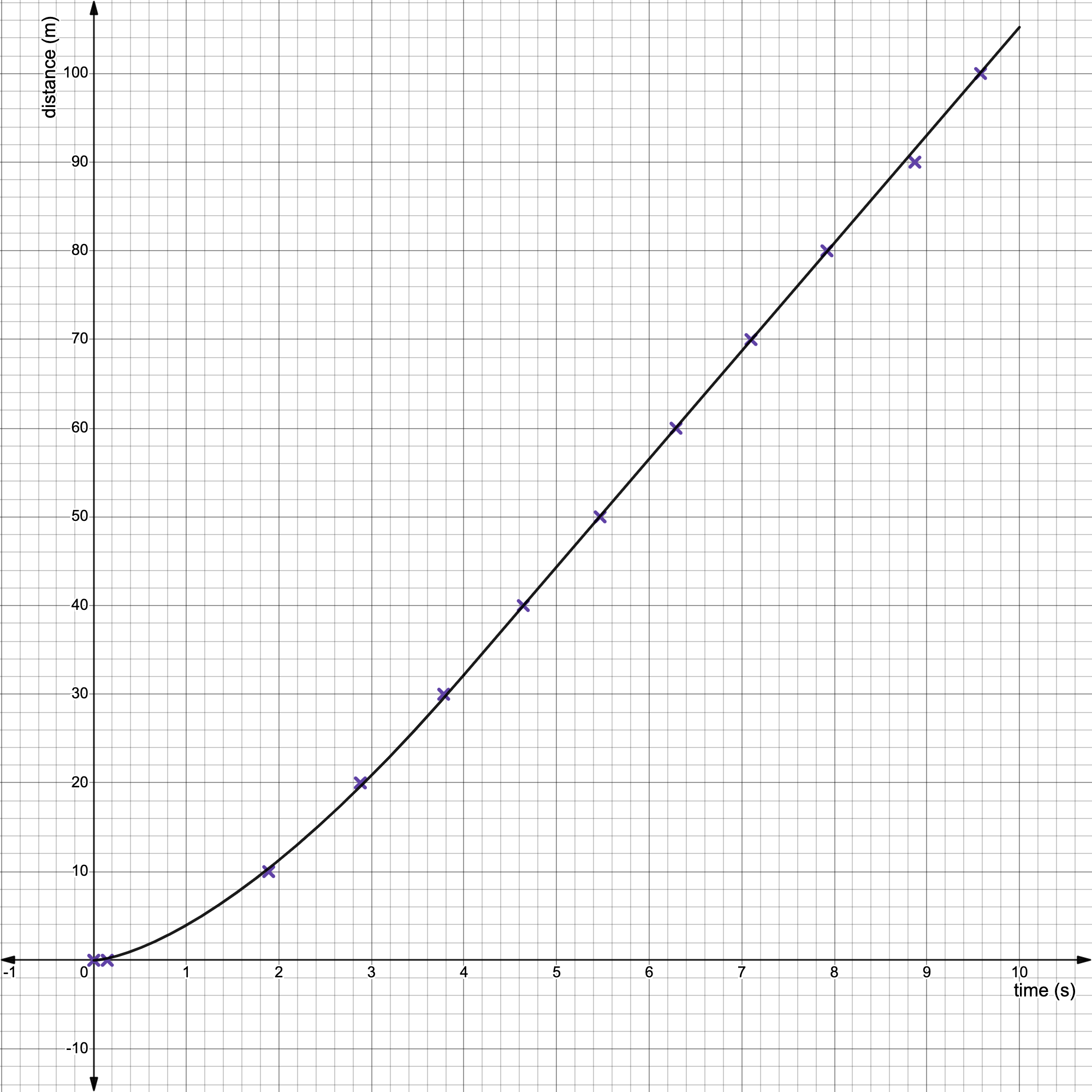Sprinting Data from the 2009 World Record 100 m Dash
The following graph shows real data for Usain Bolt's world record.† The data are plotted along with a best-fit curve.† Except for the first question, use the best-fit curve to answer the questions.
Time (s)† Distance (m) † 0.00†††† ††† 0.00 † 0.15†††† ††† 0.00 † 1.89†††† ††† 10.0 † 2.88†††† ††† 20.0 † 3.78†††† ††† 30.0 † 4.64†††† ††† 40.0 † 5.47†††† ††† 50.0 † 6.29†††† ††† 60.0 † 7.10†††† ††† 70.0 † 7.92†††† ††† 80.0 † 8.75†††† ††† 90.0 † 9.58†††† † 100.0

1. Use the data table to determine Boltís average speed for the 100 m dash.
2. Inspect the graph closely and note that there is a curved section followed by a linear section.† Use a ruler held against the linear section to determine the approximate point in time where the graph changes from a curve to a line.
3. During what interval of time was Boltís speed essentially constant and how is this apparent?
4. Determine the maximum speed attained by Bolt.† This will be the slope of the graph where ever it is maximized.† (Do not use the data table.)
5. Determine the speed of Bolt at 2.00 seconds into the race.
Hypothetical Motion of an Automobile
This graph shows plausible and realistic information for a typical car in motion along a straight road.† Note that the position of the car is related to a stoplight that the car encounters.

1. Determine the carís initial position, final position, and displacement.
2. Based on the change in position, which direction was the car moving on the road?
3. Determine the carís average velocity and its average speed.
4. Use
a ruler to determine which parts of the graph are linear and which parts are
not.† Now describe the carís motion for each distinct interval by using a
statement of the form:†
ďFrom ?† †to ? seconds the carís speed was increasing/decreasing/constant?.Ē
5. Determine the velocity of the car at 5.00 seconds.
6. Determine the velocity of the car at 12.0 seconds.
7. Determine the speed of the car at 12.0 seconds.
8. Determine the speed of the car at 25.0 seconds.
9. Determine the speed of the car at 28.0 seconds.
Answers for Usain Bolt:
1. 10.4 m/s (or 10.6 m/s excluding reaction time)
2. t = 3.8 s
3. Because slope equals speed, the linear pattern of the data shows the speed to be fairly constant in this interval of time:† 3.8 s < t < 9.8 s.
4. 12.2 m/s (thatís 27.3 mph!)
5. At t = 2.00 s, v = 8.5 m/s
Answers for Car Approaching Stoplight:
1. si
= 485 m, 90į from stoplight (or 485 m, north of stoplight)
sf = 10 m, 90į from stoplight (or 10 m, north of stoplight)
d = 475 m, 270į† (or 475 m, south)
2. The car is located north of the stoplight but traveling south on the road toward the stoplight.
3. vavg = 15.8 m/s, 270į; vavg = 15.8 m/s
4. From
0 to 10 s the carís speed was increasing.
From 10 to 22 s the carís speed was constant.
From 22 to 26 s the carís speed was decreasing.
From 26 to 30 s the carís speed was zero.
5. 12.5 m/s, 270į
6. 25.0 m/s, 270į
7. 25.0 m/s
8. 6.3 m/s
9. 0 m/s